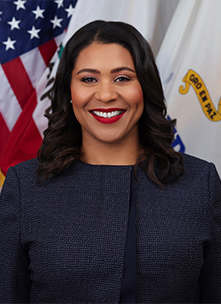A city council, town council, town board, or board of aldermen is the legislative body that governs a city, town, municipality, or local government area.

The City of London Corporation, officially and legally the Mayor and Commonalty and Citizens of the City of London, is the municipal governing body of the City of London, the historic centre of London and the location of much of the United Kingdom's financial sector.

The San Francisco Board of Supervisors is the legislative body within the government of the City and County of San Francisco, California, United States.
Michael D. Nevin was a Democratic politician from the U.S. state of California.

The mayor of the City and County of San Francisco is the head of the executive branch of the San Francisco city and county government. The officeholder has the duty to enforce city laws, and the power to either approve or veto bills passed by the San Francisco Board of Supervisors, the legislative branch. The Mayor serves a four-year term and is limited to two successive terms. Because of San Francisco's status as a consolidated city-county, the mayor also serves as the head of government of the county; both entities have been governed together by a combined set of governing bodies since 1856.

The London Government Act 1899 was an Act of the Parliament of the United Kingdom that reformed the administration of the capital. The Act divided the County of London into 28 metropolitan boroughs, replacing the 41 parish vestries and District Boards of Works administering the area. The legislation also transferred a few powers from the London County Council to the boroughs, and removed a number of boundary anomalies. The first elections to the new boroughs were held on 1 November 1900.
A board of supervisors is a governmental body that oversees the operation of county government in the American states of Arizona, California, Iowa, Mississippi, Virginia, and Wisconsin, as well as 16 counties in New York. There are equivalent agencies in other states.
Ephraim Willard Burr (1809–1894) was a businessman who served as the ninth mayor of San Francisco, California from 1856 to 1859.

The government of the City and County of San Francisco utilizes the "strong mayor" form of mayoral/council government, composed of the Mayor, Board of Supervisors, several elected officers, and numerous other entities. It is the only consolidated city-county in California, and one of only thirteen charter counties of California. The fiscal year 2019–20 city and county budget was approximately $12.3 billion.

The San Francisco Board of Supervisors is the legislative body of San Francisco, California, United States. The body consists of eleven members elected from single-member districts through ranked choice voting.
Julian Antonio Chavez was a rancher, landowner and elected official in early Los Angeles, California, who served multiple terms on the Los Angeles Common Council and the Los Angeles County Board of Supervisors. His land holdings included the area later known as Chavez Ravine.
Francis Mellus, brother of Henry Mellus, was a Los Angeles County Supervisor and a successful California business man.

California has an extensive system of local government that manages public functions throughout the state. Like most states, California is divided into counties, of which there are 58 covering the entire state. Most urbanized areas are incorporated as cities, though not all of California is within the boundaries of a city. School districts, which are independent of cities and counties, handle public education. Many other functions, especially in unincorporated areas, are handled by special districts, which include municipal utility districts, transit districts, health care districts, vector control districts, and geologic hazard abatement districts.
Julius L. Morris (1830–1909) and Morritz Morris were two German-born brothers who settled in Los Angeles, California, in 1853 and became prominent retail merchants in the newly incorporated American city as well as community leaders. Julius was a member of the Los Angeles County Board of Supervisors in 1861–63 and city treasurer in 1863–64; Morritz was a member of the Los Angeles Common Council, the governing body of the city, in 1866 for a partial term and in 1868 and 1869 for two one-year terms.
Samuel Bradford Caswell (1828–1898) was an American mining engineer, and politician in California.
James Hanley (1847–1916) was a railway man who became a member of the Los Angeles County Board of Supervisors and of the Los Angeles Common Council, the governing body of that city, in the late 19th century. He was the engineer on the first Southern Pacific transcontinental passenger train leaving from Los Angeles.
Liverpool Town Council existed from 1835 to 1880.

Joseph Britton was a lithographer, the co-founder of prominent San Francisco lithography studio Britton and Rey, and a civic leader in San Francisco, serving as a member of the Board of Supervisors and helping to draft a new city charter.

The New York City Board of Aldermen was a body that was the upper house of New York City's Common Council from 1824 to 1875, the lower house of its Municipal Assembly upon consolidation in 1898 until the charter was amended in 1901 to abolish the Municipal Assembly and its upper house, and its unicameral legislature from 1875 to 1897 and 1902 to 1937. The corresponding lower house was known as the Board of Assistants or the Board of Assistant Aldermen from 1824 to 1875, while the upper house was known as the Council from 1898 to 1901. In 1938 a new charter came into effect that replaced the Board of Aldermen with the New York City Council.

An election was held to fill the Municipal Assembly of the newly-created City of Greater New York on November 2, 1897. The charter of the new city had created a bicameral Municipal Assembly, consisting of an upper Council and a lower Board of Aldermen. Each chamber was elected from specially-made districts. In addition, the president of the Council was elected in a separate election on the same day.









